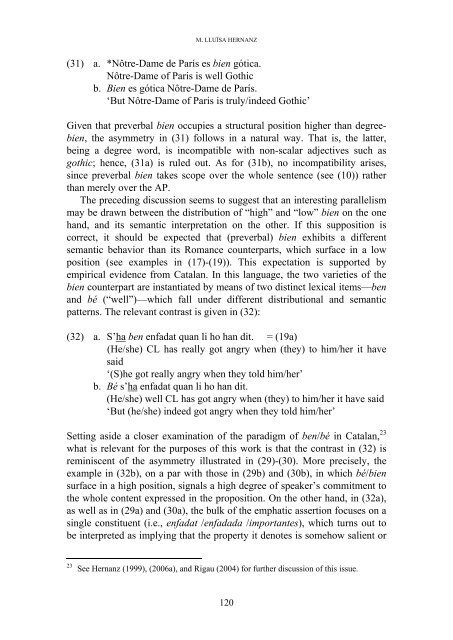Emphatic Polarity and C in Spanish - Lear
Emphatic Polarity and C in Spanish - Lear
Emphatic Polarity and C in Spanish - Lear
Create successful ePaper yourself
Turn your PDF publications into a flip-book with our unique Google optimized e-Paper software.
M. LLUÏSA HERNANZ<br />
(31) a. *Nôtre-Dame de París es bien gótica.<br />
Nôtre-Dame of Paris is well Gothic<br />
b. Bien es gótica Nôtre-Dame de París.<br />
‘But Nôtre-Dame of Paris is truly/<strong>in</strong>deed Gothic’<br />
Given that preverbal bien occupies a structural position higher than degreebien,<br />
the asymmetry <strong>in</strong> (31) follows <strong>in</strong> a natural way. That is, the latter,<br />
be<strong>in</strong>g a degree word, is <strong>in</strong>compatible with non-scalar adjectives such as<br />
gothic; hence, (31a) is ruled out. As for (31b), no <strong>in</strong>compatibility arises,<br />
s<strong>in</strong>ce preverbal bien takes scope over the whole sentence (see (10)) rather<br />
than merely over the AP.<br />
The preced<strong>in</strong>g discussion seems to suggest that an <strong>in</strong>terest<strong>in</strong>g parallelism<br />
may be drawn between the distribution of “high” <strong>and</strong> “low” bien on the one<br />
h<strong>and</strong>, <strong>and</strong> its semantic <strong>in</strong>terpretation on the other. If this supposition is<br />
correct, it should be expected that (preverbal) bien exhibits a different<br />
semantic behavior than its Romance counterparts, which surface <strong>in</strong> a low<br />
position (see examples <strong>in</strong> (17)-(19)). This expectation is supported by<br />
empirical evidence from Catalan. In this language, the two varieties of the<br />
bien counterpart are <strong>in</strong>stantiated by means of two dist<strong>in</strong>ct lexical items—ben<br />
<strong>and</strong> bé (“well”)—which fall under different distributional <strong>and</strong> semantic<br />
patterns. The relevant contrast is given <strong>in</strong> (32):<br />
(32) a. S’ha ben enfadat quan li ho han dit. = (19a)<br />
(He/she) CL has really got angry when (they) to him/her it have<br />
said<br />
‘(S)he got really angry when they told him/her’<br />
b. Bé s’ha enfadat quan li ho han dit.<br />
(He/she) well CL has got angry when (they) to him/her it have said<br />
‘But (he/she) <strong>in</strong>deed got angry when they told him/her’<br />
Sett<strong>in</strong>g aside a closer exam<strong>in</strong>ation of the paradigm of ben/bé <strong>in</strong> Catalan, 23<br />
what is relevant for the purposes of this work is that the contrast <strong>in</strong> (32) is<br />
rem<strong>in</strong>iscent of the asymmetry illustrated <strong>in</strong> (29)-(30). More precisely, the<br />
example <strong>in</strong> (32b), on a par with those <strong>in</strong> (29b) <strong>and</strong> (30b), <strong>in</strong> which bé/bien<br />
surface <strong>in</strong> a high position, signals a high degree of speaker’s commitment to<br />
the whole content expressed <strong>in</strong> the proposition. On the other h<strong>and</strong>, <strong>in</strong> (32a),<br />
as well as <strong>in</strong> (29a) <strong>and</strong> (30a), the bulk of the emphatic assertion focuses on a<br />
s<strong>in</strong>gle constituent (i.e., enfadat /enfadada /importantes), which turns out to<br />
be <strong>in</strong>terpreted as imply<strong>in</strong>g that the property it denotes is somehow salient or<br />
23 See Hernanz (1999), (2006a), <strong>and</strong> Rigau (2004) for further discussion of this issue.<br />
120

















